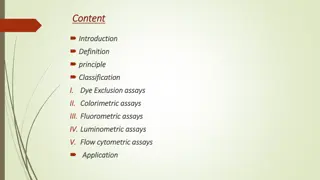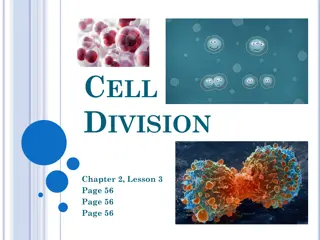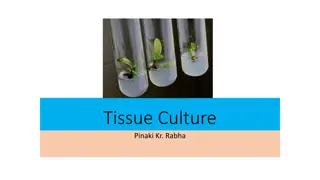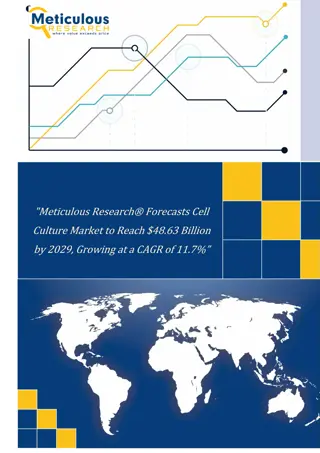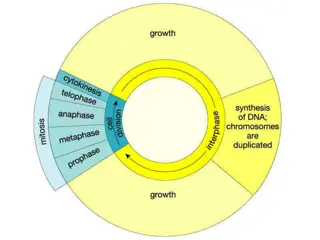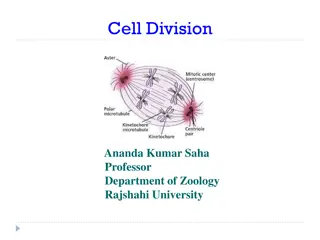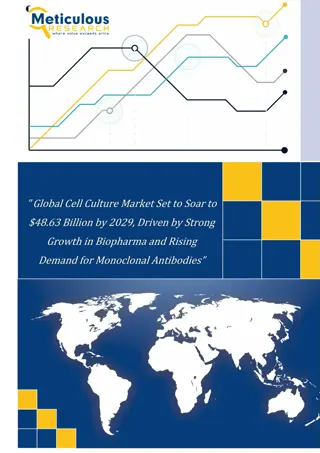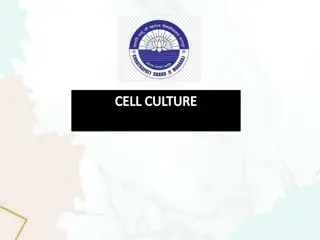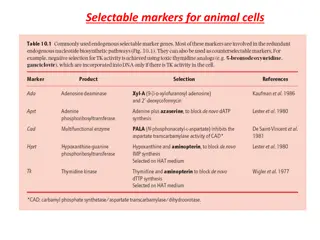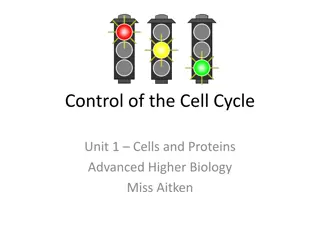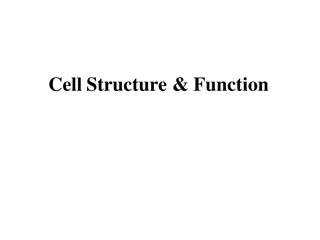Overview of Cell Culture Methods and Importance in Research
Introduction to the principles of cell culture, including tissue culture, organ culture, and cell culture methods. Discusses the advantages and disadvantages of each technique and highlights the need for cell culture in research for studying cellular behavior and large-scale production of cell materials. Emphasis on maintaining cell characteristics over generations and reproducibility in experiments.
Download Presentation

Please find below an Image/Link to download the presentation.
The content on the website is provided AS IS for your information and personal use only. It may not be sold, licensed, or shared on other websites without obtaining consent from the author.If you encounter any issues during the download, it is possible that the publisher has removed the file from their server.
You are allowed to download the files provided on this website for personal or commercial use, subject to the condition that they are used lawfully. All files are the property of their respective owners.
The content on the website is provided AS IS for your information and personal use only. It may not be sold, licensed, or shared on other websites without obtaining consent from the author.
E N D
Presentation Transcript
Introduction Cell culture is the process by which prokaryotic, eukaryotic or plant cells are grown under controlled conditions. But in practice it refers to the culturing of cells derived from animal cells. Cell culture was first successfully undertaken by Ross Harrison in 1907 Roux in 1885 for the first time maintained embryonic chick cells in a cell culture Tool for the study of animal cell biology In vitro model of cell growth Mimic of in vivo cell behaviour Artificial (some cell types are thus difficult to culture).
What is tissue culture? In vitro culture (maintain and/or proliferate) of cells, tissues or organs Types of tissue culture Organ culture Tissue culture Cell culture
Organ culture The entire embryos or organs are excised from the body and culture Advantages Normal physiological functions are maintained. Cells remain fully differentiated. Disadvantages Scale-up is not recommended. Growth is slow. Fresh explantation is required for every experiment.
Tissue Culture Fragments of excised tissue are grown in culture media Advantages Some normal functions may be maintained. Better than organ culture for scale-up but not ideal. Disadvantages Original organization of tissue is lost.
Cell Culture Tissue from an explant is dispersed, mostly enzymatically, into a cell suspension which may then be cultured as a monolayer or suspension culture. Advantages Development of a cell line over several generations Scale-up is possible Disadvantages Cells may lose some differentiated characteristics.
Why do we need Cell culture? Research To overcome problems in studying cellular behavior such as: confounding effects of the surrounding tissues variations that might arise in animals under experimental stress Reduce animal use Commercial or large-scale production Production of cell material: vaccine, antibody, hormone
Advantages Study of cell behaviour without the variations that occur in animal Control of the growth environment leads to uniformity of sample Characteristics of cells can be maintained over several generations, leading to good reproducibility between experiments Cultures can be exposed to reagents e.g. radio- chemicals or drugs at defined concentrations Finally it avoids the legal, moral and ethical problems of animal experimentation
Disadvantages Have to develop standardised techniques in order to maintain healthy reproducible cells for experiments Takes time to learn aseptic technique Quantity of material is limited Dedifferentiation and selection can occur and many of the original cellular mechanisms can be lost
Isolation of cell lines for in vitro culture Resected Tissue Cell or tissue culture in vitro Primary culture Sub-culture Secondary culture Sub-culture Cell Line Single cell isolation Successive sub-culture Immortalization Loss of control of cell growth Senescence Clonal cell line Transformed cell line Immortalised cell line
Major developments in cell culture technology First development was the use of antibiotics which inhibits the growth of contaminants. Second was the use of trypsin to remove adherent cells to subculture further from the culture vessel. Third was the use of chemically defined culture medium.
Types of Cell culture 1. Primary Cultures Derived directly from excised tissue and cultured either as Outgrowth of excised tissue in culture Dissociation into single cells (by enzymatic digestion or mechanical dispersion) Advantages: usually retain many of the differentiated characteristics of the cell in vivo Disadvantages: initially heterogeneous but later become dominated by fibroblasts. the preparation of primary cultures is labor intensive can be maintained in vitro only for a limited period of time.
Types of Cell culture 2. Continuous Cultures derived from subculture (or passage, or transfer) of primary culture Subculture = the process of dispersion and re-culture the cells after they have increased to occupy all of the available substrate in the culture usually comprised of a single cell type can be serially propagated in culture for several passages There are two types of continuous cultures Cell lines Continuous cell lines
Types of continuous culture 1) Cell lines finite life, senesce after approximately thirty cycles of division usually diploid and maintain some degree of differentiation. it is essential to establish a system of Master and Working banks in order to maintain such lines for long periods 2) Continuous cell lines can be propagated indefinitely generally have this ability because they have been transformed tumor cells. viral oncogenes chemical treatments. the disadvantage of having retained very little of the original in vivo characteristics.
Initiation of culture Tissue dispersion Primary cell culture Subculture Cell line Finite numbers Continuous cell line Indefinite numbers Stored Stored
Cell growth and differentiation in the culture depends on: The nature of cells The culture environment the nature of the substrate on which cell grow the physicochemical and physiological constitution of culture medium the constitution of gas phase the incubation temperature the cell-cell and cell-matrix interaction
Factors affecting cell behaviour in vivo The local micro-environment Cell-cell interactions Tissue architecture Tissue matrix Tissue metabolites Locally released growth factor and hormones
Culture Surface Most adherent cells require attachment to proliferate Change charge of the surface Poly-L-lysine Coating with matrix proteins Collagen, laminin, gelatin, fibronectin
Media formulation Initial studies used body fluids Plasma, lymph, serum, tissue extracts Early basal media Salts, amino acids, sugars, vitamins supplemented with serum More defined media Cell specific extremely complex
Media Formulation Inorganic ions Osmotic balance cell volume Trace Elements Co-factors for biochemical pathways (Zn, Cu) Amino Acids Protein synthesis Glutamine required at high concentrations Vitamins Metabolic co-enzymes for cell replication Energy sources glucose
Serum provides the following Basic nutrients Hormones and growth factors Attachment and spreading factors Binding proteins (albumin, transferring) carrying hormones, vitamins, minerals, lipids Protease inhibitors pH buffer
The gas phase Oxygen Aerobic metabolism Atmospheric 20% Tissue levels between 1-7% Carbon dioxide Buffering
pH Control Physiological pH 7 pH can affect Cell metabolism Growth rate Protein synthesis Availability of nutrients CO2 acts as a buffering agent in combination with sodium bicarbonate in the media
Temperature and Humidity Normal body temperature 37oC Humidity must be maintained at saturating levels as evaporation can lead to changes in Osmolarity Volume of media and additives
Culture medium for animal cell Appropriate medium Culture medium used need to : i) meet basic nutritional requirement of cells ii) support growth of cells iii) regulate the pH and osmolality iv) provide essential gasses (O2 & CO2)
a) Carbohydrates (glucose, fructose) * provide an energy sources as well as a precursor for biosynthesis b) amino acids (Glutamine) * as a sources of precursors for protein synthesis Glutamine is normally included at higher concentrations in order to act as a precursor for the TCA cycle intermediates. However, ammonia is formed from the metabolic breakdown of glutamine and can be inhibitory to growth in some cultures. Food portion of culture medium consist of :
c) Vitamins & hormones *are present at relatively low concentrations and are utilized as metabolic cofactors. Helps regulate and control the cell s growth rate and functional characteristics d) Salts *are included so that the solution is isotonic and has no imbalances with the intracellular content Helps regulate the flow of substances in and out of the cell
5) Phenol red *usually added as a pH indicator of the medium and accounts for the color of culture media 6) Additional media supplements Serum is a cell free-free liquid recovered from blood. Eg fetal bovine serum, calf serum, horse serum normally added to culture media to promote cell growth. Antibiotic are often included in media for short-term cultures in order to reduce the risk of contamination
Why sub culturing.? Once the available substrate surface is covered by cells (a confluent culture) growth slows & ceases. Cells to be kept in healthy & in growing state have to be sub-cultured or passaged It s the passage of cells when they reach to 80-90% confluency in flask/dishes/plates Enzyme such as trypsin, dipase, collagenase in combination with EDTA breaks the cellular glue that attached the cells to the surface
Adherent cells Cells which are anchorage dependent Cells are washed with PBS (free of ca & mg ) solution. Add enough trypsin/EDTA to cover the monolayer Incubate the plate at 37 C for 1-2 mts Tap the vessel from the sides to dislodge the cells Add complete medium to dissociate and dislodge the cells with the help of pipette which are remained to be adherent Add complete medium depends on the subculture requirement either to 75 cm or 175 cm flask
Suspension cells Easier to passage as no need to detach them As the suspension cells reach to confluency Asceptically remove 1/3rd of medium Replaced with the same amount of pre-warmed medium
Freezing cells for storage Remove the growth medium, wash the cells by PBS and remove the PBS by aspiration Dislodge the cells by trypsin-versene Dilute the cells with growth medium Transfer the cell suspension to a 15 ml conical tube, centrifuge at 200g for 5 mts at RT and remove the growth medium by aspiration Resuspend the cells in 1-2ml of freezing medium Transfer the cells to cryovials, incubate the cryovials at -80 C overnight Next day transfer the cryovials to Liquid nitrogen
Working with cryopreserved cells Vial from liquid nitrogen is placed into 37 C water bath, agitate vial continuously until medium is thawed Centrifuge the vial for 10 mts at 1000 rpm at RT, wipe top of vial with 70% ethanol and discard the supernatant Resuspend the cell pellet in 1 ml of complete medium with 20% FBS and transfer to properly labeled culture plate containing the appropriate amount of medium Check the cultures after 24 hrs to ensure that they are attached to the plate Change medium as the colour changes, use 20% FBS until the cells are established
Contaminants of cell culture Cell culture contaminants of two types Chemical-difficult to detect caused by endotoxins, plasticizers, metal ions or traces of disinfectants that are invisible Biological-cause visible effects on the culture they are mycoplasma, yeast, bacteria or fungus or also from cross-contamination of cells from other cell lines
Contamination Sources of Contamination of Biological-cause Bacteria Fungi Mould Yeast Mycoplasma Other cell types Free organisms, dust particles or aerosols Surfaces or equipment
Effects of Biological Contaminations They competes for nutrients with host cells Secreted acidic or alkaline by-products ceses the growth of the host cells Degraded arginine & purine inhibits the synthesis of histone and nucleic acid They also produces H2O2 which is directly toxic to cells
Detection of contaminants In general indicators of contamination are turbid culture media, change in growth rates, abnormally high pH, poor attachment, multi-nucleated cells, graining cellular appearance, vacuolization, inclusion bodies and cell lysis Yeast, bacteria & fungi usually shows visible effect on the culture (changes in medium turbidity or pH) Mycoplasma detected by direct DNA staining with intercalating fluorescent substances e.g. Hoechst 33258 Mycoplasma also detected by enzyme immunoassay by specific antisera or monoclonal abs or by PCR amplification of mycoplasmal RNA The best and the oldest way to eliminate contamination is to discard the infected cell lines directly
Basic aseptic conditions If working on the bench use a Bunsen flame to heat the air surrounding the Bunsen Swab all bottle tops & necks with 70% ethanol Flame all bottle necks & pipette by passing very quickly through the hottest part of the flame Avoiding placing caps & pipettes down on the bench; practice holding bottle tops with the little finger Work either left to right or vice versa, so that all material goes to one side, once finished Clean up spills immediately & always leave the work place neat & tidy
Safety aspect in cell culture Possibly keep cultures free of antibiotics in order to be able to recognize the contamination Never use the same media bottle for different cell lines. If caps are dropped or bottles touched unconditionally touched, replace them with new ones Necks of glass bottles prefer heat at least for 60 secs at a temperature of 200 C Switch on the laminar flow cabinet 20 mts prior to start working Cell cultures which are frequently used should be subcultered & stored as duplicate strains
The Usage of Animal Cell Culture 1) Model System Provide a good model system for studying i) basic cell biology and biochemistry; ii) interactions between disease-causing agents and cells; iii) effects of drugs on cells; process and triggers for aging and nutritional studies.
2) Toxicity Testing Widely used to study the effects of new drugs, cosmetics and chemicals on survival and growth in wide variety of cell types. 3) Cancer Research To study differences in both normal cells and cancer cells. To study the mechanism of cancer with the use of use chemicals, viruses and radiation to convert normal cultured cells to cancer causing cells.
4) Virology One of the earliest and major uses of cell culture is the replication of viruses in cell cultures for use in vaccine production. Used in the clinical detection and isolation of viruses, as well as basic research into how they grow and infect organisms.
5) Cell-Based Manufacturing Three major areas cell-based industry are large-scale production of : i) viruses for use in vaccine production (polio, rabies, chicken pox, hepatitis B and measles). ii) cells that have been genetically engineered to produce proteins that have medicinal or commercial value (monoclonal antibodies, insulin, hormones). iii) As replacement tissues and organs. Artificial skin for use intreating burns and ulcers is the first commercially available product. A potentially supply of replacement cells and tissues may come out of work currently being done with both embryonic and adult stem cells.
6) Genetic Counselling Amniocentesis, a diagnostic technique that enables doctors to remove and culture fetal cells from pregnant women. These cells can be examined for abnormalities in their chromosomes and genes. 7) Genetic Engineering To reprogram cultured cells with new genetic material (DNA and genes). Also can be used to produce new proteins in large quantity.
8) Gene Therapy The ability to genetically engineer cells has also led to their use for gene therapy. Cells can be removed from a patient lacking a functional gene and the missing or damaged gene can then be replaced. 9) Drug Screening and Development Cell-based assays have become increasingly important for the pharmaceutical industry as drugs.



